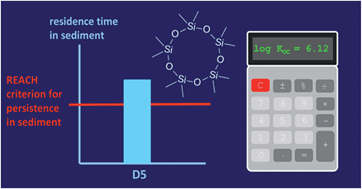当前位置:
X-MOL 学术
›
Environ. Sci.: Processes Impacts
›
论文详情
Our official English website, www.x-mol.net, welcomes your
feedback! (Note: you will need to create a separate account there.)
A critical assessment of the environmental fate of linear and cyclic volatile methylsiloxanes using multimedia fugacity models
Environmental Science: Processes & Impacts ( IF 4.3 ) Pub Date : 2017-12-18 00:00:00 , DOI: 10.1039/c7em00524e Dimitri Panagopoulos 1, 2, 3, 4, 5 , Matthew MacLeod 1, 2, 3, 4, 5
Environmental Science: Processes & Impacts ( IF 4.3 ) Pub Date : 2017-12-18 00:00:00 , DOI: 10.1039/c7em00524e Dimitri Panagopoulos 1, 2, 3, 4, 5 , Matthew MacLeod 1, 2, 3, 4, 5
Affiliation

|
We apply multimedia models to systematically evaluate the fate profile of cyclic volatile methyl siloxanes (VMS) D4, D5 and D6, and the linear VMS L4 and L5 using recently reported measurements of their partition ratios between organic carbon and water (KOC), their salting out constants (Ks), and their enthalpy of sorption to organic carbon (ΔHOC). Our assessment follows a multi-stage strategy where the environmental fate of the chemicals is explored in generic regional models with increasing fidelity to the real system and in a region-specific model. Modeled emissions of VMS to air remained in air and were degraded or advected out of the system with overall residence times ranging from 2.4 to 2.5 days, while emissions to water resulted in accumulation in sediment and longer residence times ranging from 29.5 to 1120 days. When emitted to water the modeled residence times of VMS in the sediment exceeded the REACH criterion for persistence in freshwater sediments. Reported KOC measurements for D5 differ by 1 log unit, which results in a 500-day difference in the overall residence times calculated in the generic regional modeling. In the specific-region modeling assessment for Adventfjorden, Svalbard in Norway, the different KOC measurements of D5 resulted in a 200-day difference in overall residence times. Model scenarios that examined combinations of previously published ΔHOC or enthalpy of phase change between octanol and water (ΔHOW) for D5 in combination with the range of the KOC measurements resulted in 1100-days difference in overall residence times. Our results demonstrate that residence times of VMS in aquatic systems are highly sensitive to their degree of sorption to organic carbon, and that residence times of VMS likely exceed several persistence criteria and therefore they cannot be considered as non-persistent.
中文翻译:

使用多媒体逸度模型对线性和环状挥发性甲基硅氧烷的环境命运进行严格评估
我们应用多媒体模型来系统评估环状挥发性甲基硅氧烷(VMS)D 4,D 5和D 6以及线性VMS L 4和L 5的命运,使用最近报道的有机碳和水之间分配比例的测量结果(K OC),其盐析常数(K s)及其对有机碳的吸附焓(ΔH OC)。我们的评估遵循多阶段策略,其中在通用区域模型中探索化学品的环境命运,以提高对真实系统的忠诚度,并在特定于区域的模型中进行探索。VMS排放到空气中的模型保留在空气中,并且已退化或向系统外平流,总停留时间为2.4到2.5天,而向水排放则导致沉积物中积聚,更长的停留时间为29.5到1120天。当排放到水中时,VMS在沉积物中的模型停留时间超过了REACH准则中对淡水沉积物的持久性。报告的D 5的K OC测量相差1个对数单位,这将导致在通用区域建模中计算出的总停留时间相差500天。在挪威斯瓦尔巴特群岛Adventfjorden的特定区域建模评估中,对D 5的不同K OC测量导致总停留时间相差200天。模型方案检查了D 5的先前发布的ΔH OC或辛醇与水之间的相变焓(ΔH OW)的组合以及K OC的范围测量结果导致总停留时间相差1100天。我们的结果表明,VMS在水生系统中的停留时间对其对有机碳的吸附程度高度敏感,并且VMS的停留时间可能超过了几个持久性标准,因此不能将其视为非持久性的。
更新日期:2017-12-18
中文翻译:

使用多媒体逸度模型对线性和环状挥发性甲基硅氧烷的环境命运进行严格评估
我们应用多媒体模型来系统评估环状挥发性甲基硅氧烷(VMS)D 4,D 5和D 6以及线性VMS L 4和L 5的命运,使用最近报道的有机碳和水之间分配比例的测量结果(K OC),其盐析常数(K s)及其对有机碳的吸附焓(ΔH OC)。我们的评估遵循多阶段策略,其中在通用区域模型中探索化学品的环境命运,以提高对真实系统的忠诚度,并在特定于区域的模型中进行探索。VMS排放到空气中的模型保留在空气中,并且已退化或向系统外平流,总停留时间为2.4到2.5天,而向水排放则导致沉积物中积聚,更长的停留时间为29.5到1120天。当排放到水中时,VMS在沉积物中的模型停留时间超过了REACH准则中对淡水沉积物的持久性。报告的D 5的K OC测量相差1个对数单位,这将导致在通用区域建模中计算出的总停留时间相差500天。在挪威斯瓦尔巴特群岛Adventfjorden的特定区域建模评估中,对D 5的不同K OC测量导致总停留时间相差200天。模型方案检查了D 5的先前发布的ΔH OC或辛醇与水之间的相变焓(ΔH OW)的组合以及K OC的范围测量结果导致总停留时间相差1100天。我们的结果表明,VMS在水生系统中的停留时间对其对有机碳的吸附程度高度敏感,并且VMS的停留时间可能超过了几个持久性标准,因此不能将其视为非持久性的。











































 京公网安备 11010802027423号
京公网安备 11010802027423号